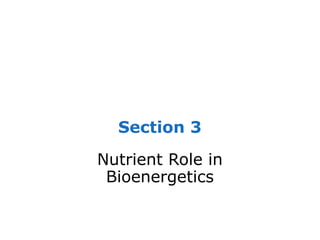
Section+3+bioenergetics (1)
- 1. Section 3 Nutrient Role in Bioenergetics
- 2. Bioenergetics Bioenergetics refers to the flow of energy within a living system. Energy is the capacity to do work. Aerobic reactions require oxygen. Anaerobic reactions do not require oxygen.
- 3. Light energy ECOSYSTEM Photosynthesis in chloroplasts CO2 + H2O Organic +O molecules 2 Cellular respiration in mitochondria ATP ATP powers most cellular work Heat energy
- 5. Overview Electrons Electrons carried carried via NADH and via NADH FADH2 Oxidative Glycolysis Citric phosphorylation: acid electron transport Glucose Pyruvate cycle and chemiosmosis Mitochondrion Cytosol ATP ATP ATP Substrate-level Substrate-level Oxidative phosphorylation phosphorylation phosphorylation
- 6. NADH 50 2 e– NAD+ FADH2 2 e– FAD Multiprotein 40 Ι FAD complexes FMN Fe•S Fe•S Ι Free energy (G) relative to O2 (kcal/mol) Ι Q ΙΙ Cyt b Ι Fe•S 30 Cyt c1 IV Cyt c Cyt a Cyt a3 20 10 2 e– (from NADH or FADH2) 0 2 H+ + 1/2 O2 H2O
- 8. Energy Sources Sources for ATP formation include: • Carbohydrates: • Glucose derived from liver glycogen • Lipids: • Triacylglycerol and glycogen molecules stored within muscle cells • Free fatty acids derived from triacylglycerol (in liver and adipocytes) that enter the bloodstream for delivery to active muscle • Protein: • Intramuscular and liver-derived carbon skeletons of amino acids
- 9. Energy Release from Carbohydrates The primary function of carbohydrates is to supply energy for cellular work. The complete breakdown of 1 mole of glucose liberates 689 kCal of energy. • Of this, ATP bonds conserve about 261 kCal (38%), with the remainder dissipated as heat.
- 10. Glucose Degradation Occurs in two stages: 1. Anaerobic: Glucose breaks down relatively rapidly to 2 molecules of pyruvate. 2. Aerobic: Pyruvate degrades further to carbon dioxide and water.
- 11. NADH 50 2 e– NAD+ FADH2 2 e– FAD Multiprotein 40 Ι FAD complexes FMN Fe•S Fe•S Ι Free energy (G) relative to O2 (kcal/mol) Ι Q ΙΙ Cyt b Ι Fe•S 30 Cyt c1 IV Cyt c Cyt a Cyt a3 20 10 2 e– (from NADH or FADH2) 0 2 H+ + 1/2 O2 H2O
- 12. Glycolysis Energy investment phase Glucose Glycogen catabolism 2 ADP + 2 P 2 ATP used Substrate-level phosphorylation in glycolysis Energy payoff phase Hydrogen formed 4 ADP + 4 P 4 ATP release in glycolysis 2 NAD+ + 4 e– + 4 H+ 2 NADH + 2 H+ Lactate formation 2 Pyruvate + 2 H2O Net Glucose 2 Pyruvate + 2 H2O 4 ATP formed – 2 ATP used 2 ATP 2 NAD+ + 4 e– + 4 H+ 2 NADH + 2 H+
- 13. Production of Lactate Glucose Glycolysis CYTOSOL Pyruvate No O2 present: O2 present: Anaerobic Aerobic cellular respiration MITOCHONDRION lactate Acetyl CoA Citric acid cycle
- 14. Energy Release from Fat Stored fat represents the body’s most plentiful source of potential energy. Energy sources for fat catabolism include: • Triacylglycerol stored directly within the muscle fiber • Circulating triacylglycerol in lipoprotein complexes • Circulating free fatty acids
- 15. Breakdown of Glycerol and Fatty Acids Glycerol • Provides carbon skeletons for glucose synthesis Fatty acids • Beta (ß)-oxidation converts a free fatty acid to multiple acetyl-CoA molecules. • Hydrogens released during fatty acid catabolism oxidize through the respiratory chain.
- 17. Adipocytes Adipose tissue serves as an active and major supplier of fatty acid molecules. Triacylglycerol fat droplets occupy up to 95% of the adipocyte cell’s volume. Free fatty acids either form intracellular triacylglycerols or bind with intramuscular proteins and enter the mitochondria for energy metabolism.
- 19. Lipogenesis The formation of fat, mostly in the cytoplasm of liver cells Occurs when excess glucose or protein is not used immediately to sustain metabolism, so it converts into stored triacylglycerol The lipogenic process requires ATP energy and the B vitamins biotin, niacin, and pantothenic acid.
- 20. Energy Release from Protein Protein plays a role as an energy substrate during endurance activities and heavy trainings. Deamination: Nitrogen is removed from the amino acid molecule. Transamination: When an amino acid is passed to another compound. The remaining carbon skeletons enter metabolic pathways to produce ATP.
- 22. Overview Electrons Electrons carried carried via NADH and via NADH FADH2 Oxidative Glycolysis Citric phosphorylation: acid electron transport Glucose Pyruvate cycle and chemiosmosis Mitochondrion Cytosol ATP ATP ATP Substrate-level Substrate-level Oxidative phosphorylation phosphorylation phosphorylation
Editor's Notes
- Anaerobic and aerobic breakdown of ingested food nutrients provides the energy source for synthesizing the chemical fuel that powers all forms of biologic work.
- ATP and PCr provide anaerobic sources of phosphate-bond energy. The energy liberated from the hydrolysis of PCr rebonds ATP and P to form ATP.
- Figure 9.6 An overview of cellular respiration
- Glycolysis, a series of 10 enzymatically controlled chemical reactions creates two molecules of pyruvate from the anaerobic breakdown of glucose.
- Glycolysis, a series of 10 enzymatically controlled chemical reactions creates two molecules of pyruvate from the anaerobic breakdown of glucose.
- Glycogenolysis describes the cleavage of glucose from stored glycogen. Energy transfers directly via phosphate bonds in the anaerobic reactions called substrate-level phosphorylation. During glycolysis, two pairs of hydrogen atoms are stripped from the substrate (glucose), and their electrons are passed to NAD+ to form NADH . Lactate provides a valuable source of chemical energy that accumulates in the body during heavy exercise.
- Prior to energy release from fat, hydrolysis ( lipolysis or fat breakdown) splits the triacylglycerol molecule into glycerol and three water-insoluble fatty acid molecules.
- Lipogenesis begins with carbons from glucose and the carbon skeletons from amino acid molecules that metabolize to acetyl-CoA.
- Once an amino acid loses its nitrogen-containing amine group, the remaining compound (usually a component of the citric acid cycle’s reactive compounds) contributes to ATP formation. Excessive intake of protein is converted to body fat.
- Figure 9.6 An overview of cellular respiration
